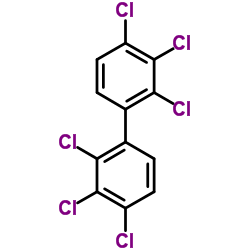PCB No(Aroclor 1260)158 solution

PCB No(Aroclor 1260)158 solution structure
|
Common Name | PCB No(Aroclor 1260)158 solution | ||
|---|---|---|---|---|
| CAS Number | 11096-82-5 | Molecular Weight | 360.878 | |
| Density | 1.6±0.1 g/cm3 | Boiling Point | 403.8±40.0 °C at 760 mmHg | |
| Molecular Formula | C12H4Cl6 | Melting Point | 115.76°C (estimate) | |
| MSDS | N/A | Flash Point | 198.9±24.7 °C | |
| Symbol |




GHS02, GHS07, GHS08, GHS09 |
Signal Word | Danger | |
| Name | 2,2',3,3',4,4'-PCB |
|---|---|
| Synonym | More Synonyms |
| Density | 1.6±0.1 g/cm3 |
|---|---|
| Boiling Point | 403.8±40.0 °C at 760 mmHg |
| Melting Point | 115.76°C (estimate) |
| Molecular Formula | C12H4Cl6 |
| Molecular Weight | 360.878 |
| Flash Point | 198.9±24.7 °C |
| Exact Mass | 357.844421 |
| LogP | 6.73 |
| Vapour Pressure | 0.0±0.9 mmHg at 25°C |
| Index of Refraction | 1.627 |
| Storage condition | room temp |
| Symbol |




GHS02, GHS07, GHS08, GHS09 |
|---|---|
| Signal Word | Danger |
| Hazard Statements | H225-H304-H315-H336-H373-H410 |
| Precautionary Statements | P210-P261-P273-P301 + P310-P331-P501 |
| Personal Protective Equipment | Eyeshields;Faceshields;full-face respirator (US);Gloves;multi-purpose combination respirator cartridge (US);type ABEK (EN14387) respirator filter |
| Hazard Codes | F,N,Xn,T |
| Risk Phrases | 11-23/24/25-39/23/24/25-67-65-62-51/53-48/20-38-50/53-33-52/53-45 |
| Safety Phrases | 36/37-45-62-61-60-33-29-16-9-53 |
| RIDADR | 2315 |
| Packaging Group | II |
|
Extensive biodegradation of polychlorinated biphenyls in Aroclor 1242 and electrical transformer fluid (Askarel) by natural strains of microorganisms indigenous to contaminated African systems
Chemosphere 73(1) , 126-32, (2008) Evidence for substantial aerobic degradation of Aroclor 1242 and Askarel fluid by newly characterized bacterial strains belonging to the Enterobacter, Ralstonia and Pseudomonas genera is presented. Th... |
|
|
Use of a polar ionic liquid as second column for the comprehensive two-dimensional GC separation of PCBs.
J. Chromatogr. A. 1217(37) , 5859-67, (2010) The orthogonality of three columns coupled in two series was studied for the congener specific comprehensive two-dimensional GC separation of polychlorinated biphenyls (PCBs). A non-polar capillary co... |
|
|
Transcriptome-wide gene expression in a rat model of attention deficit hyperactivity disorder symptoms: rats developmentally exposed to polychlorinated biphenyls.
Am. J. Med. Genet. B. Neuropsychiatr. Genet. 156B(8) , 898-912, (2011) Polychlorinated biphenyls (PCB) exposure in rodents provides a useful model for the symptoms of Attention deficit hyperactivity disorder (ADHD). The goal of this study is to identify genes whose expre... |
| 1,1'-Biphenyl, hexachloro- |
| 2,2',3,3',4,4'-PCB |
| 2,2',3,3',4,4'-Hexachlorobiphenyl |
| Hexachloro-1,1'-biphenyl |
| 1,1'-Biphenyl, 2,2',3,3',4,4'-hexachloro- |